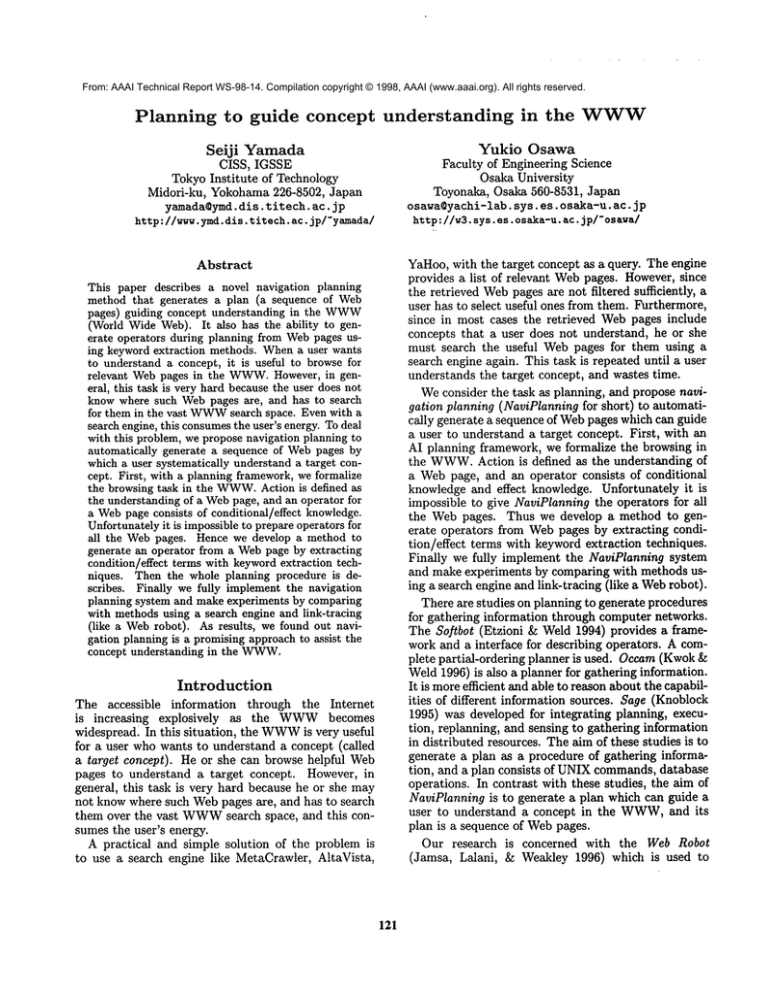
From: AAAI Technical Report WS-98-14. Compilation copyright © 1998, AAAI (www.aaai.org). All rights reserved.
Planning
to guide
concept
understanding
in the
WWW
Yukio
Osawa
Seiji
Yamada
Faculty of Engineering Science
CISS, IGSSE
Osaka University
Tokyo Institute of Technology
Toyonaka, Osaka 560-8531, Japan
Midori-ku, Yokohama226-8502, Japan
osawa©yachi-lab,
sys.es. osaka-u,
ac. jp
yamada@ymd,
dis.titech,
ac.j p
sys.es.osaka-u,
ac.jp/’osawa/
http://www,
ymd.dis.titech,
ac.j p/’yamada/ http://w3.
Abstract
This paper describes a novel navigation planning
method that generates a plan (a sequence of Web
pages) guiding concept understanding in the WWW
(World Wide Web). It also has the ability to generate operators during planning from Webpages using keyword extraction methods. Whena user wants
to understand a concept, it is useful to browse for
relevant Webpages in the WW’W.
However, in general, this task is very hard because the user does not
knowwhere such Webpages are, and has to search
for them in the vast WWW
search space. Even with a
search engine, this consumesthe user’s energy. Todeal
with this problem, we propose navigation planning to
automatically generate a sequence of Webpages by
which a user systematically understand a target concept. First, with a planning framework,we formalize
the browsing task in the WWW.
Action is defined as
the understanding of a Webpage, and an operator for
a Webpage consists of conditional/effect knowledge.
Unfortunatelyit is impossibleto prepare operators for
all the Webpages. Hence we develop a method to
generate an operator from a Webpage by extracting
condition/effect terms with keywordextraction techniques. Then the whole planning procedure is describes. Finally we fully implement the navigation
planning system and make experiments by comparing
with methodsusing a search engine and link-tracing
(like a Webrobot). As results, we found out navigation planning is a promising approach to assist the
concept understanding in the WWW.
Introduction
The accessible information through the Internet
is increasing
explosively
as the WWW
becomes
widespread. In this situation, the WWW
is very useful
for a user who wants to understand a concept (called
a target concept). He or she can browse helpful Web
pages to understand a target concept. However, in
general, this task is very hard because he or she may
not know where such Webpages are, and has to search
them over the vast WWW
search space, and this consumes the user’s energy.
A practical and simple solution of the problem is
to use a search engine like MetaCrawler, AltaVista,
121
YaHoo,with the target concept as a query. The engine
provides a list of relevant Webpages. However, since
the retrieved Webpages are not filtered sufficiently, a
user has to select useful ones from them. Furthermore,
since in most cases the retrieved Webpages include
concepts that a user does not understand, he or she
must search the useful Web pages for them using a
search engine again. This task is repeated until a user
understands the target concept, and wastes time.
Weconsider the task as planning, and propose navigation planning (NaviPlanning for short) to automatically generate a sequence of Webpages which can guide
a user to understand a target concept. First, with an
AI planning framework, we formalize the browsing in
the WWW.
Action is defined as the understanding of
a Webpage, and an operator consists of conditional
knowledge and effect knowledge. Unfortunately it is
impossible to give NaviPlanning the operators for all
the Web pages. Thus we develop a method to generate operators from Webpages by extracting condition/effect terms with keyword extraction techniques.
Finally we fully implement the NaviPlanning system
and make experiments by comparing with methods using a search engine and link-tracing (like a Webrobot).
There are studies on planning to generate procedures
for gathering information through computer networks.
The Softbot (Etzioni & Weld 1994) provides a framework and a interface for describing operators. A complete partial-ordering planner is used. Occam(Kwok
Weld 1996) is also a planner for gathering information.
It is moreefficient and able to reason about the capabilities of different information sources. Sage (Knoblock
1995) was developed for integrating planning, execution, replanning, and sensing to gathering information
in distributed resources. The aim of these studies is to
generate a plan as a procedure of gathering information, and a plan consists of UNIXcommands,database
operations. In contrast with these studies, the aim of
NaviPlanning is to generate a plan which can guide a
user to understand a concept in the WWW,
and its
plan is a sequence of Webpages.
Our research is concerned with the Web Robot
(Jamsa, Lalani, & Weakley 1996) which is used
gather Webpages for a search engine database. However it is not controlled and traces to only linked pages.
NaviPlanning can trace to unlinked pages, and is controlled for generating a plan.
Somelearning systems have been developed for information gathering and browsing in the WWW.
ShopBot (Doorenbos, Etzioni, & Weld 1997) learns the
text pattern indicating the price of CD-ROMs,and
searches for the cheapest one more efficiently than a
human. The purpose of ShopBot is different from our
research. WebWatcher (Armstrong et al. 1995) and
Letizia (Lieberman 1995) are able to indicate the Web
pages which a user wants to see next. Using browsing history, they learn to predict useful Webpages
for a user. Unfortunately they indicate only related
Webpages to the current page, and do not generate
systematic guidance for understanding a concept like
NaviPlanning.
Navigation
planning
In this research, navigation meansa task that indicates
useful Webpages to a user for guiding his concept understanding. A sequence of useful Webpages is called
a plan, and navigation planning means the automatic
generation of the plan.
By using an AI planning framework, we formalize
the task that a user browses useful Webpages to understand a target concept. Wecan summarize the task
in the following. This procedure is repeated until terminated by the user.
1. Search Webpages related to target concepts using a
search engine.
2. Understand the Webpages retrieved by the search
engine.
3. Select unknownconcepts in the Webpages.
4. Go to Step l with unknownconcepts as target concepts.
The procedure above is considered planning (Fikes
& Nilsson 1971)(Russell & Norvig 1995) using the following correspondence.
¯ Action: understanding concepts described in a Web
page.
¯ State: A user’s knowledge state: a set of words describing concepts which he knows.
¯ Initial state: A user’s initial knowledgestate.
¯ Goal state: a set of words which a user wants to
understand.
¯ Operator: U-Op(URL)describing action is defined
by the followings.
- Label: URLof the Web page
- Condition: C = {cl, -.-, ci}, where C means the
condition knowledge which is necessary to understand the Webpages, and ck is an element (called
a condition word).
122
- Effect: E = {el, ..., ej}, where E is e~ect knowledge which a user obtains by understanding the
Webpage, and el is an element (called an effect
word).
The condition knowledge and effect knowledge are
described with a set of words describing the knowledge. Using this formalization, we can apply a classical
planning framework (Fikes & Nilsson 1971)(Russell
Norvig 1995) to navigation planning.
This NaviPlanning contains a significant problem
which has not been in planning thus far. It is that
the U-Op(URL)operators are not given in advance.
This is because it is impossible for a humandesigner
to generate the operators from all the Webpages in the
WWW.
Hence the operators need to be automatically
generated from Webpages when they are necessary. In
next section, we develop the method.
Generating
operators
from
Web pages
Wedevelop a method to extract condition and effect
knowledge from a Webpage in order to generate an
operator. Since the condition/effect words are assumed
to be written in the Webpage, thus the problem is how
to extract condition/effect words from a Webpage (an
html file).
Using TAG structure
in a html-file
Various methods to extract keywords from text have
been studied (Salton & Buckley 1997). Though most
methods are based on frequency of words, one of the
most effective methods is to utilize the structure in
a text. Since a Web page is described in a HTML
format (Berners-Lee & Connolly 1995), we can utilize
TAGstructures like <TITLE>,<Hn>,<h HREF=... >, for
extracting condition/effect knowledge.
Extracting condition words The prime candidates for condition words are the words linked to other
Webpages, i.e. the words between <h HREF=URL>
and
</A>, because an author explicitly indicates that the
words are important for understanding the Webpage.
They have URLfor a useful Webpage to understand
the words.
Howeverall the linked words are not meaningful. For
example, a commercial Webpage may be linked to the
Webpage of it’s sponsor company. Hence we filter the
candidates from <h HREF=URL>
tag using KeyGraph as
mentioned later.
Extracting effect words Since the title of the Web
page describes words which a user acquires by reading
the page, the words between <TITLE> and </TITLE>
are candidates for the effect words. In the same way,
headings describe knowledge which a user obtains by
reading the section. Thus the words between <Hn>and
</nn> are also candidates for effect words.
ods such as TFIDF(Salton~ Mc~ill1983)have to
revisethe corpuswhennewdocuments
occur.Accordingly,keywords
of all thedocuments
already
indexed
haveto be revisedagain- an enormous
lossof time
especially
in the WWW,where many new and progressing topics appear in new Webpages everyday.
The extraction of condition/effect words using tag
structure and KeyGraph are integrated, and the detailed procedure Ext-OP is shown in Fig.1.
Input
¯ Input file (html-file or plain text file) and it’s
URL
Control parameters
¯ Weight for <TITLE>: c~, Weight for <Hn>: /3,
Weight for <A HREF=URL>:
7
¯ The number of condition words: Nc
¯ The number of effect words: WE
Output
¯ An operator U-Op(URL) (URL, co ndition
knowledge, effect knowledge).
Planning
procedure
We now develop NaviPlanning procedure. Fig.2 shows
the overview of NaviPlanning. It uses backward beam
search (Russell & Norvig 1995) from a goal state
(Fig.2(a)). The node expansion (Fig.2(b)) includes
search for related Webpages with a search engine and
the generation of operators with Ext-OP.
The detail of input, output and a procedure for the
NaviPlanning is shownin Fig.3 and Fig.4. In this research, the evalution function H for a node is defined
with the following formula.
Procedure
1. By KeyGraph, generate candidates C for condition knowledge and candidates E for effect
knowledge from an input file. The candidates
have weight within [0, 1].
2. Add the words between <Sn> and </Hn> with
weight/3 to E.
3. Add the words between <TITLE>and </TITLE>
with weight c~ to E.
4. Change the weight of the overlaping words
between C and the words between each <A
HREF=URL>
and </A> to 7.
5. Select the Arc maximumweighted words in C
for conditional knowledge and the ArE maximum weighted words in E for effect knowledge, and generate an operator U-Op(URL). If
a word in condition knowledge is extracted by
<A HREFfURL>and has a URL, the URLis assigned to the condition word.
H=
E Weight of a satisfied
subgoa!
+ ~ Weight of effect words satisfying
subgoa!
Fig.5 shows a plan (limited depth I = 4) generated
by NaviPlanning with the target concept "Turing test
" and context "Turing". Four useful Webpages are
indicated with hyperlinked titles and URLs.
Pruning and caching
Web pages
Additional procedures:
pruning and caching Web
pages are introduced to accelerate NaviPlanning. We
experimentally found that many Webpages have little
information to understand something. For example,
the Webpage having only linked URLsor references,
or extremely short or long pages. Since the operator
Figure h Ext-OP: procedure of generating an operator
KeyGraph:
a keyword
extraction
method
The extraction of condition/effect words using only the
tag structure is not sufficient. All the linked words are
not candidates for condition words, and all the condition words are linked. Thus we need to utilize another
method to assist it, and KeyGraphis used.
KeyGraph is a fast method for extracting keywords
representing the asserted core idea in a document (Ohsawa, Benson, & Yachida 1998). KeyGraph composes
clusters of terms, based on co-occurrences between
terms in a document. Each cluster represents a concept
on which the documentis based (i.e. condition words),
and terms connecting clusters tightly are obtained as
author’s assertion (i.e. effect words). Furthermore the
likelihood for condition/effect words can be computed
by KeyGraph, and used for weight of an operator.
Another merit of KeyGraph is that it does not employ a corpus. Generally speaking, corpus-based meth-
123
Subgoalof node-i )
quew
;
I Asearch#ngi~e
I
Widthof beamsearch
(a)Navigation
planning
as
backwardbeam search
(b) Node expanding from nodc-i
Figure 2 Navigation planning (overview)
Input
¯ Goal state (= target concepts) Go : a set of the
words which a user wants to understand.
¯ Context GC: a set of the words describing the
background domain of the goal state.
Control parameters
¯ Initial state IS : a user’s initial knowledgestate.
¯ Limited depth l : planning stops at depth I.
¯ Limited number of Webpage w : the number of
the Webpages obtained from a search engine.
¯ Width b for beam search.
¯ Evaluation function H : evaluating the states
in planning.
Output
¯ A plan P : a set of sequences of U-Op(URL).
Figure 3 Input and output for Navigation planning
generated from a meaningless Webpage is meaningless,
such Webpages are pruned in Step3d of Fig.4.
Caching is also done by storing the Webpages obtained in Step3c of Fig.4. If a cached Webpage is
available in Step3c of Fig.4, it is used and planning is
accelerated more than two times.
Experiments
and Results
Accuracy of operators
formation
In the first phase of experiments, we investigated how
accurately the operators in the navigation planing were
formed. The procedure in this experiment is as follows:
1) Take a document (a Webpage) D, from a plan
a query (the goal state and context). Let Cond and
Elf denote the sets of words obtained from D, as
the condition words and effect words respectively.
2) For Cond : Count C, the number of words in
Cond, and c, the number of really necessary condition words of D, i.e. words in Cond without understanding which the reader cannot understand document D. Also count Ce, the number of words in
Cond which seem to actually be effect words.
3)For Eff : Count E, the number of words in E f f,
and e, the number of effect words understandable by
reading D. Also count Ec, the number of terms in
Eff which seem to actually be condition words.
The results from 23 Web pages &re: C = 494, c =
367, E = 331, e = 228, Ce = 15, Ec = 25.
From these values, we obtain c/C = 0.74 and e/E =
0.68, which mean the accuracy of condition words and
effect words respectively. Wehave no previous methods to compare with these values, because no previous indexing methodobtains condition or effect words.
124
1. Initialize
No = [no] = [(G0,[])], i - 0. (Ni
is a sequence of nodes at depth i. A node is
described as nl = (Gi,Pi), where Gi is a set
of the words for a subgoal, and a plan P~ is a
sequence of operators.)
2. If i = I or Ni is null then this procedure outputs
P and stops.
3. Apply the following procedures to all the nodes
n in Ni, and initialize Ni+l = [].
(a) Extract D (called difference): a subset of G
which is not included in IS.
(b) Obtain w Web pages’ URLs by inputing D U
GCas query to a search engine.
(c) Get the Webpages (html files) of the obtained
URLthrough a TCP/IP connection.
(d) Generate operators from the obtained Web
pages using the Ext-OP procedure. Then
apply the following procedure to the operators which the intersection between its effect
knowledge E and n’s subgoal G is not empty.
Get G’ by eliminating the operator’s E from
n’s G and adding the operator’s C. Getting
P’ by adding the operator to the head of n’s
plan P. Then a new node (G’, P’) is added
to Nn+x.
4. Evaluate all node in Nn+I using an evaluation
function H, and update Nn+a with the best b
nodes.
5. Set i = i + 1 and go to Step2.
Figure 4 Navigation planning procedure
However,we can at least say that words separated into
Cond and Eff as expected, because the overall rate
of real conditional and effect terms are muchless than
0.74 and 0.68, i.e. (c + Ec)/(c + Ec + e + Ce) = 0.62
and (e + Ce)/(c + Ec + e + Ce) = 0.38.
Operators are further evaluated in the next experiment, considering the practical utility of NaviPlanning.
Efficiency
of understanding
goal terms
In the second experiment, the utility of NaviPlanning -was directly evaluated. The Me.taCrawlerX(Sel
berg & Etzioni 1995)(Selberg & Etzioni 1997) search
engine was employed for node expansion (Fig.2(b))
NaviPlanning, and also used for the purpose of user’s
understanding of a target concept. The performances
of these two methods, combinedwith link-tracing (like
a Webrobot) or not, were compared. In all experiments, the control parameters (Fig.3) in NaviPlanning
were set as IS = [], l = 4, w = 8, b = 4, and the control
1 http://www.metacrawler.com/
she read thex~txleved
pages in ~t~ order as ~orted
by NaviPlanning, being allowed to trace links from
the pages being read, until he or she understood the
goal term explicitly.
Methodo5: The user traced links only from the toppage of MetaCrawler. The user was not allowed to
start from other retrieved pages of MetaCrawler.
¯ TARG~
CONCEtC
= "TucinKtest"
= Turing
¯ CO~EXT
1..Eval = 1.75 SUB-GOAL
(21) = kosaza::a~clcan::critici~::human
~lligan~: :c~p~em::years:: 19~o1885:
:tmive~sity:: 20:: first: :haltir~: :au
~orld
[I]
: :squ~’es[l]::design[I]::
1. TurfngTest [ac.,at]
43 queries were tested for each method. The number
of clearly understood goals by Method-1 and Method-3
was both 26 goals. Method-5 did the far poorest, making the user understand only 13 goals. These values
may sound as though MetaCrawler and NaviPlanning
performed equally fine, and tracing links was of no use.
However,let us consider one more significant factor
- the effort of the user in each procedure. This factor
mayclarify the difference of tested methods. The first
effect we observed was that NaviPlanning remarkably
helps the user in understanding goal terms efficiently.
For 9 queries, the user of Method-3 was satisfied with
his or her own understanding by the first page read,
while Method-1 users were in only 6 cases. This fact
implies that operators were obtained quite well, i.e.
effect words of the start (top) page of NaviPlanning
corresponded to the assigned goal.
The second effect observed was that tracing links
helped in understanding pages which were not understood without tracing links. In total, 13 goals were
newly understood by adding link-tracing (i.e., in Methods 2 and 4), among34 goals which failed to be understood without tracing links.
Due to all these effects, Method-4 was be the most
effort-saving approach for the user. Fig.6 compares
user effort in the two most effective methods, i.e.,
Method-2 and 4. Twofeatures are remarkable in Fig.6.
One is that Method-4 (NaviPlanning + Tracing Links)
enabled a user to understand goals while reading many
fewer pages than Method-2 (Search engine + Tracing
Links). The other feature is that Method-2 requires
greater effort of the user for a larger number of pages
retrieved by MetaCrawler. This means that, for a popular term (e.g. "MIDI"in digital music, or "genetic algorithm" in the AI area) which is already prevalent in
the WWW,
it is relatively rare that a page is devoted
for defining the term. In other words, common-sense
terms are not desired or intended to be defined.
http://stttc[2,
tt~ien,
ac,at~e9425704/turln{~
ht~l
i~
=:)
¯’
1
I
=i
)
(~ = m~tL8] tucing[B]kos~aCT.5] am~icm~[7]¢rit3cJ~[~ hum~
in~Z~nce[~
EFFECT
= ¢cit~i~rl] t~ tuzing te~[1] t~[0.50~52]
~gence [E 3?8757]
2.ACMIutln~
A~atd
Lectures: TheFirst
20Years
(18~-1985)
http;//Jnfo, ac~or~/oatalog/books/70287
O. html
COND
= compu~.r[O.
00203458788593082]
years[O.
00101729399796~I]
196B-19~5
[0.001017293997965411
tmiversity(O,
0010172939979(~
20[0.
00101729399786~1]
flrst((k
O0101729~q/8(go41]
EFFECT
= acre
~urir~
a#erd
lecture~:
thefirst
20years
(1966-1985)
[2]
order[0.304977]
acm[O.
2/168]book[{).24961]
91.htm1:
Restricted
llaltin~
Problem?
http://&life, santMe,edt~alife/topics/c~/~xchi~s/91/Ol71,
html
exist[0.751 turing ~him[g751
EFFECT
= 91.html: rest;rioted balt3~ problea?[2]robert[l] restricted
halting
problem?[l]
black[0.619148]
~.~
ht tp://cs~-~w, stanfot~d, edu~p/Tuc~l,
html
COND
= cs].i.[1.25] logic[l.25] soft~am[1.~5]
turing ~orld[t]
sqvares[l]
desisn[l]
EFFECT
= tt~in~s
e)rld:
more~fomat~on(1)[2]tuzln~
machine~[l]
s~mbo~
[0. 69~06]ma=~
[0. 6,T/Gmj
)
Figure 5 Plan for "Turing test"
parameters (Fig.l)
in Ext-OP were set as weights
NC = 6, WE = 4. Since IS is null,
NaviPlanning stopped at depth = 4, and only 4-step
plans were generated. The time taken to generate a
plan by NaviPlanning was 2 ~ 3 hours (the most part
was taken for getting Webpages). Additionally experiments with depth = 8 were made, however planning
was not completed in most cases.
In more concrete words, we compared the following
five methods.
Method-l: Search engine Goal state and context
terms were given as a query, constraining that the
goal must be included in each page to be retrieved.
The user read only the retrieved pages in the order as
sorted by MetaCrawler, until he or she understood
the goal term clearly.
Method-2: Search engine ~- Tracing links
Queries were given as in Method-1. Then the user
read the retrieved pages in the order as sorted by
MetaCrawler, being allowed to trace links from the
pages being read, until he or she understood the goal
term explicitly.
Method-3: NaviPlanning The user gave the goal
term and context terms separately to NaviPlanning.
Then, he or she read the retrieved pages in the order
as sorted by NaviPlanning.
Method-4: NaviPlanning -{- Tracing links
Queries were given as in Method-3. Then, he or
= 2,
~ = 1,
"y = 1,
Discussion
In the experiments above, NaviPlanning was verified
to help a user in efficiently understanding a target concept. The only observation above which may look
discouraging for NaviPlanning is that the number of
successfully understood pages were almost equal for
NaviPlanning and MetaCrawler.
However,the content of the pages which failed to be
understood were quite different between the two methods. This implies that there are both advantages and
disadvantages in the current version of NaviPlanning.
125
Thenumber
of pages
accessed
before
understandir)g
goalterms
+ : Search
Engine
(MetaCrawler)
+ Tracing
links
o : Navigation
Planner
+Tracing
links
4"
+4"+
4"4"
+
+
O
10
20
+O
O
O
+OOO
QQO QO
30
I
4"
4"
+O
O
+O++
+O@++Q
O
i
+O
4"
O
40
50
Thenumber
of pages
retrieved
by MetaCrawler
Figure 6: Comparison of the performance of two best
methods.
The major advantage is that NaviPlanning enables efficient planning for understanding a target concept, by
finely formed operators. On the other hand, according
to more detailed data, the disadvantage was that because of the width of beam search, it does not retrieve
so manypages directly concerned with the target concept as search engines do. Here is the risk of leading
to a misguided plan beginning from a badly retrieved
start page (the top page of NaviPlanning). Currently
we are thinking of letting a user select the start page,
as the next stage of this research.
Conclusion
Weproposed a novel navigation planning method that
generates a plan guiding understanding of a concept in
the WWW.
It also has the ability to generate operators
during planning from Webpages using keyword extraction methods. The search for useful Webpages for a
user to understand goal concepts was formalized using
a planning framework, and an operator corresponding to the understanding of a Webpage was defined
with conditional/effect
knowledge. Then we described
the whole planning procedure. Finally we fully implemented the navigation planning system and made experiments by comparing with methods using a search
engine and link-tracing (like a Webrobot). As results,
we found NaviPlanning a promising approach to assist
information retrieval in the WWW.
126
Armstrong, R.; Freitag,
D.; Joachims, T.; and
Mitchell, T. 1995. WabWatcher: A learning apprentice for the World Wide Web. In The 1995 AAAI
Spring Symposium on Information Gathering from
Heterogeneous, Distributed Environment. AAAI.
Berners-Lee, T., and Connolly, D. 1995. Hypertext
Markup Language - ~.0. RFC 1866.
Doorenbos, R. B.; Etzioni, O.; and Weld, D. S. 1997.
A scalable comparison-shopping agent for the WorldWide Web. In Proceedings of the First International
Conference on Autonomous Agent, 39-48.
Etzioni, O., and Weld, D. 1994. A SoftBot-based
interface to the Internet. Communicationof the A CM
37(7):72-76.
Fikes, R. E., and Nilsson, N. J. 1971. STRIPS: A
new approach to the application of theorem proving
to problem solving. Artificial Intelligence 2:189-208.
Jamsa, K.; Lalani, S.; and Weakley, S. 1996. Web
Programming. Jamsa Press.
Knoblock, C. A. 1995. Planning, executing, sensing,
and replanning for information gathering. In Proceedings of the Fourteenth International Joint Conference
on Artificial Intelligence, 1686-1693.
Kwok, C. T., and Weld, D. S. 1996. Planning to
gather information. In Proceedings of the Thirteenth
National Conference on Artificial Intelligence, 32-39.
Lieberman, H. 1995. Letizia: A agent that assists
Webbrowsing. In Proceedings of the Fourteenth International Joint Conference on Artificial Intelligence,
924-929.
Ohsawa, Y.; Benson, N. E.; and Yachida, M. 1998.
KeyGraph: Automatic indexing by co-occurrence
graph based on building construction metaphor. In
Advanced Digital Library Conference. to appear.
Russell, S., and Norvig, P. 1995. Artificial Intelligence
-A Modern Approach-. Prentice-Hall.
Salton, G., and Buckley, C. 1997. Term-weighting approaches in automatic text retrieval. In Jones, K. S.,
and Willet, P., eds., Readings in Information Retrieval edt.), Morgan Kaufmann. Morgan Kaufmann.
323-328.
Salton, G., and McGill, M. J. 1983. Introduction to
modern information retrieval. McGraw-Hill.
Selberg, E., and Etzioni, O. 1995. Multi-service
search and comparison using the metacrawler. In the
1995 World Wide Web Conference.
Selberg, E., and Etzioni, O. 1997. The metacrawler
architecture for resource aggregation on the Web. In
IEEE Expert, volume January-February. 11-14.






